 W
WThe mollusc shell is typically a calcareous exoskeleton which encloses, supports and protects the soft parts of an animal in the phylum Mollusca, which includes snails, clams, tusk shells, and several other classes. Not all shelled molluscs live in the sea; many live on the land and in freshwater.
 W
WThe anal sulcus, also called the anal sinus or anal canal, in Gastropods is a notch, a shelly tube at the top of the aperture. It is the first notch close to the suture. It houses the anal siphon through which the snail expels water and waste products.
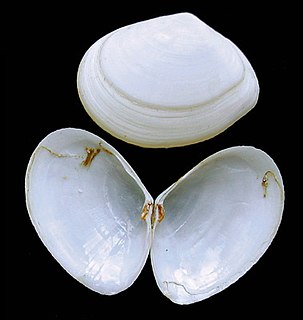 W
WA bivalve shell is part of the body, the exoskeleton or shell, of a bivalve mollusk. In life, the shell of this class of mollusks is composed of two hinged parts or valves. Bivalves are very common in essentially all aquatic locales, including saltwater, brackish water, and freshwater. The shells of bivalves commonly wash up on beaches and along the edges of lakes, rivers, and streams. Bivalves by definition possess two shells or valves, a "right valve" and a "left valve", that are joined by a ligament. The two valves usually articulate with one another using structures known as "teeth" which are situated along the hinge line. In many bivalve shells, the two valves are symmetrical along the hinge line—when truly symmetrical, such an animal is said to be equivalved; if the valves vary from each other in size or shape, inequivalved. If symmetrical front-to-back, the valves are said to be equilateral, and are otherwise considered inequilateral.
 W
WThe body whorl is part of the morphology of the shell in those gastropod mollusks that possess a coiled shell. The term is also sometimes used in a similar way to describe the shell of a cephalopod mollusk.
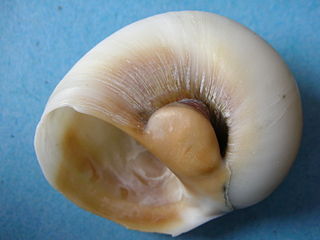 W
WA callus is an anatomical feature that exists in some mollusk shells, a thickened area of shell material that can partly or completely cover the umbilicus, or can be located as a coating on the body whorl near the aperture of the shell.
 W
WThe columella or pillar is a central anatomical feature of a coiled snail shell, a gastropod shell. The columella is often only clearly visible as a structure when the shell is broken, sliced in half vertically, or viewed as an X-ray image.
 W
WConch is a common name of a number of different medium- to large-sized sea snail or shells, generally those of large snails whose shell has a high spire and a noticeable siphonal canal.
 W
WConch, or conque, also known as a "seashell horn" or "shell trumpet", is a wind instrument that is made from a conch, the shell of several different kinds of sea snails. Their natural conical bore is used to produce a musical tone. Conch shell trumpets have been played in many Pacific Island countries, as well as South America and Southern Asia.
 W
WThe gastropod shell is part of the body of a gastropod or snail, a kind of mollusc. The shell is an exoskeleton, which protects from predators, mechanical damage, and dehydration, but also serves for muscle attachment and calcium storage. Some gastropods appear shell-less (slugs) but may have a remnant within the mantle, or the shell is reduced such that the body cannot be retracted within (semi-slug). Some snails also possess an operculum that seals the opening of the shell, known as the aperture, which provides further protection. The study of mollusc shells is known as conchology. The biological study of gastropods, and other molluscs in general, is malacology. Shell morphology terms vary by species group. An excellent source for terminology of the gastropod shell is "How to Know the Eastern Land Snails" by John B. Burch now freely available at the Hathi Trust Digital Library.
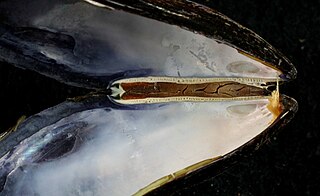 W
WA hinge line is an imaginary longitudinal line along the dorsal edge of the shell of a bivalve mollusk where the two valves hinge or articulate. The hinge line can easily be perceived in these images of a mussel shell and an ark shell.
 W
WHinge teeth are part of the anatomical structure of the inner surface of a bivalve shell, i.e. the shell of a bivalve mollusk. Bivalves by definition have two valves, which are joined together by a strong and flexible ligament situated on the hinge line at the dorsal edge of the shell. In life, the shell needs to be able to open slightly to allow the foot and siphons to protrude, and then close again, without the valves moving out of alignment with one another. To make this possible, in most cases the two valves are articulated using an arrangement of structures known as hinge teeth. Like the ligament, the hinge teeth are also situated along the hinge line of the shell.
 W
WIn the shell of gastropod mollusks, the lip is the free margin of the peristome or aperture of the gastropod shell.
 W
WA lunule is an anatomical feature which is found in the exterior surface of the shells of some species of clams, bivalve mollusks, as for example in the family Veneridae and in the genus Ascetoaxinus.
 W
WA parietal callus is a feature of the shell anatomy of some groups of snails, i.e. gastropods. It is a thickened calcareous deposit which may be present on the parietal wall of the aperture of the adult shell. The parietal wall is the margin of the aperture and part of the wall of the body whorl that is closest to the columella. The callus is often smooth and glossy, but can also be decorated with raised ribs or wrinkles.
 W
WA pearl is a hard, glistening object produced within the soft tissue of a living shelled mollusk or another animal, such as fossil conulariids. Just like the shell of a mollusk, a pearl is composed of calcium carbonate in minute crystalline form, which has deposited in concentric layers. The ideal pearl is perfectly round and smooth, but many other shapes, known as baroque pearls, can occur. The finest quality of natural pearls have been highly valued as gemstones and objects of beauty for many centuries. Because of this, pearl has become a metaphor for something rare, fine, admirable and valuable.
 W
WThe periostracum is a thin organic coating or "skin" which is the outermost layer of the shell of many shelled animals, including molluscs and brachiopods. Among molluscs it is primarily seen in snails and clams, i.e. in gastropods and bivalves, but it is also found in cephalopods such as Allonautilus scrobiculatus. Periostracum is an integral part of the shell, and it forms as the shell forms, along with the other shell layers.
 W
WA plait is an anatomical feature which is present the shells of some snails, or gastropods. This sculpture occurs often in the shells of marine gastropod mollusks in the clade Neogastropoda, but it is also found in some pulmonate land snails.
 W
WPlanispiral is a condition in which a tubicolous shell is coiled in a single horizontal plane and the diameter increases away from the axis of coiling. This term is usually used for describing gastropod shells. Many cephalopods and tubeworms can also have a planispiral shell.
 W
WA prodissoconch is an embryonic or larval shell which is present in the larva of a bivalve mollusk. The prodissoconch is often but not always smooth, and has no growth lines. It is sometimes still present and visible in the adult shell, if there has been no erosion of the shell in that area.
 W
WA protoconch is an embryonic or larval shell which occurs in some classes of molluscs, e.g., the initial chamber of an ammonite or the larval shell of a gastropod. In older texts it is also called "nucleus". The protoconch may sometimes consist of several whorls, but when this is the case, the whorls show no growth lines.
 W
WA resilifer is a part of the shell of certain bivalve mollusks. It is either a recess or a process, the function of which is the attachment of an internal ligament, which holds the two valves together.
 W
WIn anatomy, a resilium is part of the shell of certain bivalve mollusks. It is an internal ligament, which holds the two valves together and is located in a pit or depression known as the resilifer.
 W
WSculpture is a feature of many of the shells of mollusks. It is three-dimensional ornamentation on the outer surface of the shell, as distinct from either the basic shape of the shell itself or the pattern of colouration, if any. Sculpture is a feature found in the shells of gastropods, bivalves, and scaphopods. The word "sculpture" is also applied to surface features of the aptychus of ammonites, and to the outer surface of some calcareous opercula of marine gastropods such as some species in the family Trochidae.
 W
WA seashell or sea shell, also known simply as a shell, is a hard, protective outer layer usually created by an animal that lives in the sea. The shell is part of the body of the animal. Empty seashells are often found washed up on beaches by beachcombers. The shells are empty because the animal has died and the soft parts have been eaten by another animal or have decomposed.
 W
WSeashell resonance refers to a popular folk myth that the sound of the ocean may be heard through seashells, particularly conch shells. This effect is similarly observed in any resonant cavity, such as an empty cup or a hand clasped to the ear.
 W
WA selenizone is an anatomical structure that exists in the shells of some families of living sea snails: the slit shells, the little slit shells and the abalones, which are marine gastropod mollusks from ancient lineages.
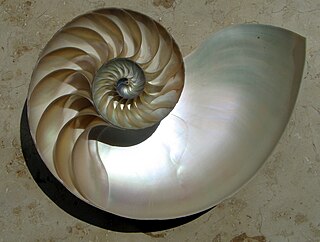 W
WSepta are thin walls or partitions between the internal chambers (camerae) of the shell of a cephalopod, namely nautiloids or ammonoids.
 W
WShell growth in estuaries is an aspect of marine biology that has attracted a number of scientific research studies. Many groups of marine organisms produce calcified exoskeletons, commonly known as shells, hard calcium carbonate structures which the organisms rely on for various specialized structural and defensive purposes. The rate at which these shells form is greatly influenced by physical and chemical characteristics of the water in which these organisms live. Estuaries are dynamic habitats which expose their inhabitants to a wide array of rapidly changing physical conditions, exaggerating the differences in physical and chemical properties of the water.
 W
WA shell purse is a type of coin purse that is made from whole or trimmed mollusk shells, especially from bivalve mollusc shells. These purses are of mainly novelty use and purchased as souvenirs of visits, etc. In the past, some were engraved or painted with floral or other decorations, sentimental messages, personal or place names. In many cases there was extra working of the shell, either grinding down and polishing to expose the mother of pearl or filing to form patterns such as criss-cross designs.
 W
WThe siphonal canal is an anatomical feature of the shells of certain groups of sea snails within the clade Neogastropoda. Some sea marine gastropods have a soft tubular anterior extension of the mantle called a siphon through which water is drawn into the mantle cavity and over the gill and which serves as a chemoreceptor to locate food. In certain groups of carnivorous snails, where the siphon is particularly long, the structure of the shell has been modified in order to house and protect the soft structure of the siphon. Thus the siphonal canal is a semi-tubular extension of the aperture of the shell through which the siphon is extended when the animal is active.
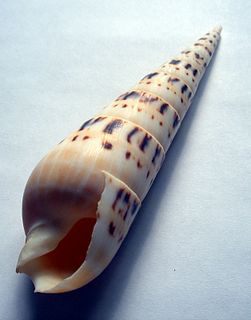 W
WA siphonal notch is a feature of the shell anatomy in some sea snails, marine gastropod mollusks.
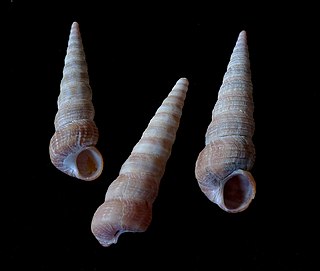 W
WA spire is a part of the coiled shell of molluscs. The spire consists of all of the whorls except for the body whorl. Each spire whorl represents a rotation of 360°. A spire is part of the shell of a snail, a gastropod mollusc, a gastropod shell, and also the whorls of the shell in ammonites, which are fossil shelled cephalopods.
 W
WThe stromboid notch is an anatomical feature which is found in the shell of one taxonomic family of medium-sized to large sea snails, the conches.
 W
WIn biology, a test is the hard shell of some spherical marine animals, notably sea urchins and microorganisms such as testate foraminiferans, radiolarians, and testate amoebae. The term is also applied to the covering of scale insects. The related Latin term testa is used for the hard seed coat of plant seeds.
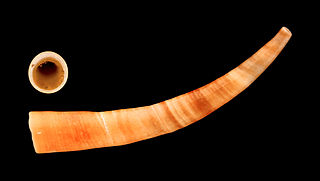 W
WThe tusk shells or tooth shells, often referred to by the more-technical term scaphopods, are members of a class of shelled marine mollusc with worldwide distribution, and are the only class of exclusively infaunal marine molluscs. Shells of species within this class range from about 0.5 to 15 cm in length. Members of the order Dentaliida tend to be significantly larger than those of the order Gadilida.
 W
WThe umbilicus of a shell is the axially aligned, hollow cone-shaped space within the whorls of a coiled mollusc shell. The term umbilicus is often used in descriptions of gastropod shells, i.e. it is a feature present on the ventral side of many snail shells, including some species of sea snails, land snails, and freshwater snails.
 W
WA varix is an anatomical feature of the shell of certain sea snails, marine gastropod molluscs. Gastropods whose shells have varices are primarily families and species within the taxonomic groups Littorinimorpha and Neogastropoda.
 W
WA whorl is a single, complete 360° revolution or turn in the spiral growth of a mollusc shell. A spiral configuration of the shell is found in of numerous gastropods, but it is also found in shelled cephalopods including Nautilus, Spirula and the large extinct subclass of cephalopods known as the ammonites.